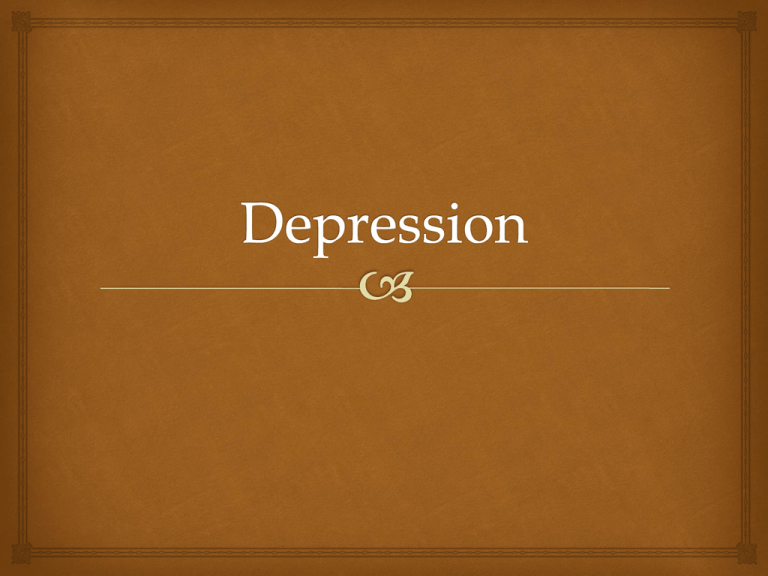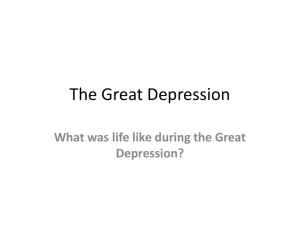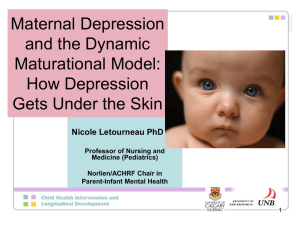Depression
advertisement

Symptoms of a Major Depressive Disorder Affective: guilt and sadness, lack of enjoyment or pleasure in familiar activities or company. Behavioural: passivity Cognitive: negative thoughts, faulty attribution of blame, low self esteem, irrational hopelessness, difficulty concentrating, indecisiveness Somatic: lack of energy, insomnia or hypersomnia, weight loss/gain, diminished libido. Diagnosis of Depression When someone experiences two weeks of depressed mood or loss of interest or pleasure. Diagnosis requires at least 4 additional symptoms (such as insomnia, suicidal thoughts, passivity, or difficulty concentrating). Facts about Depression Depression affects 15% of people at some time in their life (Charney and Weismann 1988). Depression tends to be a recurrent disorder with about 80% experiencing a subsequent episode. Depression is 2-3 times more common in women than in men. It occurs frequently among members of lower socioeconomic groups. Levav (1997) found the prevalence rate to be above average in Jewish males suggesting that some groups are more prone to depression. Serotonin & Depression Prozac: blocks the reuptake of serotonin thereby leaving more serotonin in the synaptic gap/cleft. Serotonin is known to affect mood, emotions, aggression, sleep and anxiety. Noradrenaline & Depression Another neurotransmitter called noradrenaline is found to be correlated with depression. Janowsky et al. (1972) Participants were given a drug called physostigmine (which lowers noradrenaline but increases acetylcholine). They experienced feelings of self-hate and suicidal wishes within minutes. Cocktail of Neurotransmitters? Rampello et al. (2000) found depressed patients to have an imbalance of noradrenaline, serotonin, dopamine (pleasure), acetylcholine (memory). Skeptics say that pinning depression to just neurotransmitters is too simple and reductionist (reducing complex behavior to a single factor). Stress & Depression Cortisol: a hormone that helps us cope with stress. Cortisol hypothesis: Too much or too little cortisol levels may predispose an individual to depression. Cushing’s syndrome: a disease which results in excessive production of cortisol. There is a high prevalence of depression among people with Cushing’s syndrome. Overproduction of cortisol may decrease the density of serotonin receptors and damage noradrenaline receptors. However, people develop depression without being stressed and people who have experienced terrible stress do not always develop depression. Does poverty cause depression? Fernald and Gunnar (2008) Surveyed 639 Mexican mothers and their children. Children of depressed mothers living in extreme poverty produced less cortisol. This indicates a “worn out” stress system that leaves children susceptible to depression. Cognition and Depression Ellis (1962) Proposed that irrational thinking causes depression, not the other way around. Beck (1976) Observed that depressed patients’s thoughts are characterized by: Overgeneralization based on negative events Non-logical inference about oneself Dichotomous thinking (black and white thinking) Beck’s theory of Cognitive Restructuring Identifies negative, self-critical thoughts Notes the connection between negative thought and depression. Examines each negative thought and decides whether it can be supported. Replaces distorted negative thought with realistic interpretations of each situation. Buehler & O’Brien (2011) 1364 mothers across the US were studied and one child in the family were studied. Interviews and observations were made during the child’s 1st, 3rd, and 5th grade years. Findings Full-time and part-time mothers reported fewer symptoms of depression than stay-at-moms. Part-time moms were just as involved in their child’s schooling as stay-at-home moms and were actually more sensitive with their pre-school children than stay-at-home moms. Diathesis-stress Model Depression is a result of genetic predisposition and severe life events such as: Unemployment Having more than 3 children under 14 at home Absence of social support Loss of mother at a young age Having suffered child abuse Brown and Harris 1978 Studied 458 women in London aged between 18 and 65 years. Researchers used surveys and interviews on the women’s life and depressive episodes. Findings In the previous year, 8% of the women had been depressed. 90% those who became depressed had recently experienced a severe life event. Only 20% of women who had experienced severe difficulties became seriously depressed. 23% of working class women had been depressed within the past year compared to 3% of middle class women.








